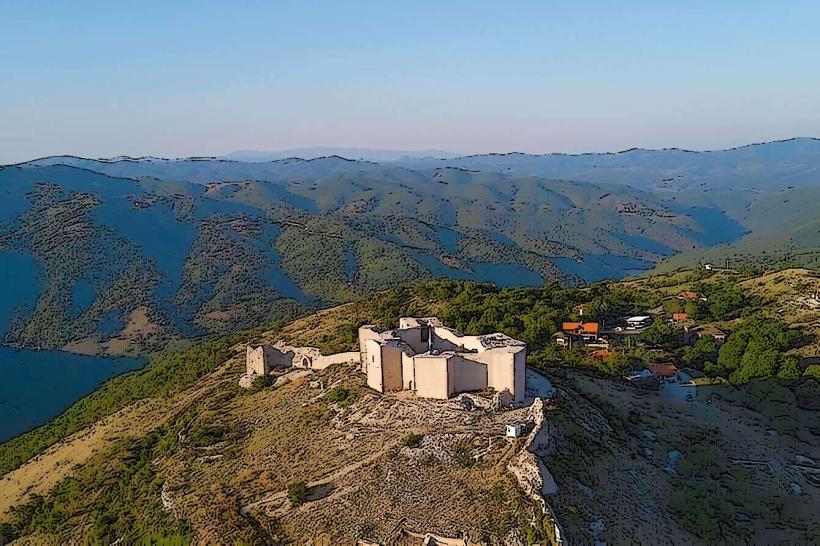Information
Landmark: Tomb of Ali PasheCity: Shtime
Country: Kosovo
Continent: Europe
The Tomb of Ali Pasha Shtime is a notable historical and cultural site located in Shtime, Kosovo. It is associated with Ali Pasha, a prominent figure during the late Ottoman period, specifically in the 19th century, who was an influential local leader in the region. The tomb serves as a reminder of the area's Ottoman past and the historical figures who played key roles in shaping the local and regional history.
Historical Background
Ali Pasha:
- Ali Pasha was an Ottoman administrator who held significant power in the region during the late 18th and early 19th centuries. He governed several territories under the Ottoman Empire, including the Shtime area. Known for his administrative skills and military acumen, Ali Pasha had a reputation as a formidable leader.
- Although not as widely recognized as figures like Ali Pasha of Ioannina in Greece, Ali Pasha Shtime played a local but important role in the administration of the Ottoman-controlled regions. His tomb stands as a marker of his influence in this part of Kosovo.
Ottoman Legacy:
- As with many other figures from the Ottoman era, the Tomb of Ali Pasha Shtime is part of the broader legacy of the Ottoman Empire’s long rule over the Balkans. The region of Shtime was under Ottoman control for several centuries, and many of the historical and architectural remnants, such as mosques, bridges, and tombs, are tied to this period.
- Ali Pasha's tomb, like many others from the Ottoman period, is not just a burial site but also a symbolic landmark of the region's Ottoman heritage.
Architectural Features
- Simple yet Elegant Design:
- The tomb of Ali Pasha Shtime is relatively simple in its design, in line with many Ottoman-era tombs that prioritize function and modesty over elaborate ornamentation. However, the structure may still carry elements typical of the time, such as stone carving or Islamic calligraphy on inscriptions.
- Tomb Structure:
- The tomb is likely a mausoleum-type structure, which was common for prominent individuals during the Ottoman period. Such tombs were often constructed with a stone base, and the grave would be marked by a tombstone with inscriptions detailing the name and accomplishments of the individual.
- Location:
- The tomb is located within the town of Shtime, but its exact location may not always be prominently marked or may be situated in a cemetery or near other Ottoman structures. The surrounding area likely reflects the town’s Ottoman influence, with other mosques or historic buildings in the vicinity.
Cultural and Symbolic Importance
Historical Significance:
- The tomb of Ali Pasha Shtime represents not only the historical significance of the Ottoman period in Kosovo but also the local history of Shtime. As a local leader, Ali Pasha contributed to the social, economic, and political life of the region, and his tomb serves as a memorial to his legacy.
Cultural Heritage:
- The tomb is an important part of Shtime’s cultural heritage, reflecting the town's historical connection to the broader Ottoman Empire and the Balkans’ Islamic traditions. It contributes to the understanding of local history, especially in terms of governance, military leadership, and cultural assimilation during the Ottoman era.
Tourism and Local Identity:
- For local residents and visitors alike, the Tomb of Ali Pasha represents a link to Shtime’s past and the broader cultural history of Kosovo. It is a point of interest for those exploring the Ottoman legacy in the region, as well as for those interested in the specific historical figures who shaped the local landscape.
Commemoration and Memory:
- The tomb also serves as a place of commemoration for the community, where historical memory is preserved, and the leadership of the past is honored. It reflects the respect for ancestors and the historical context of the time.
Current Condition
- Preservation and Access:
- The condition of the Tomb of Ali Pasha Shtime may vary depending on local efforts to preserve historical sites. As with many historical tombs, the challenge of maintenance and protection can affect their accessibility and condition. Some sites are better preserved, while others may have deteriorated over time due to natural causes or neglect.
- Visitation:
- The tomb may not be as well-known internationally as other historical sites in Kosovo, but it remains important for local history enthusiasts and those interested in the Ottoman period of the Balkans. It is still accessible to visitors and offers a window into the local history of Shtime.
Conclusion
The Tomb of Ali Pasha Shtime is a historical and cultural landmark that represents the town's Ottoman heritage and the leadership of a significant local figure. It serves as a reminder of the region's complex history, bridging the past and present of Shtime. Although modest in design, the tomb is a symbol of respect for the past and a valuable asset for understanding the Ottoman impact on the region’s culture and identity.





